TDWI Best Practices Reports
TDWI’s Best Practices Reports are designed to educate technical and business professionals about new business intelligence technologies, concepts, or approaches that address a significant problem or issue. Research for the Best Practices Reports is conducted via interviews with industry experts and leading-edge user companies, and is supplemented by a survey of business intelligence professionals.
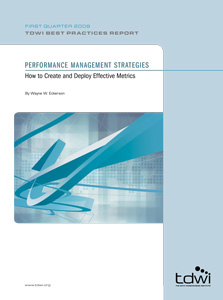
January 9, 2009
Performance metrics are a powerful tool of organizational change. The adage "What gets measured, gets done," is true. Companies that define objectives, establish goals, measure progress, reward achievement, and display the results for all to see can turbo-charge productivity and gracefully move an organization in a new direction.
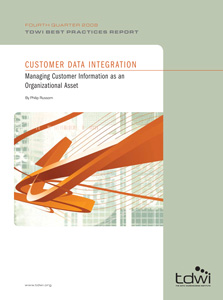
October 1, 2008
Who are your customers? Which products and services are they buying across your enterprise? How much business have they transacted with your enterprise so far this year? Where do they conduct business besides your firm?
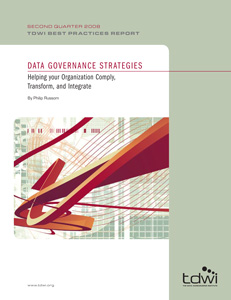
April 1, 2008
Any time data crosses an organizational boundary, it should be governed, whether you’re sharing data among business units internally or publishing data to customers, partners, auditors, and regulatory bodies externally. Organizations are under renewed pressure to ensure that compliance and accountability requirements are met as the scope of data integration broadens. In response to this situation, many organizations are turning to data governance, which establishes policies and procedures for sharing data, as well as improving data’s quality, structure, and auditability.
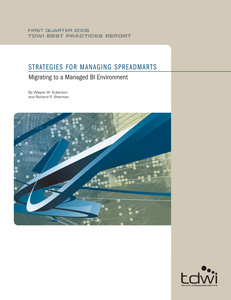
January 1, 2008
In organizations all over the world, business people bypass their IT groups to get data from spreadmarts. Spreadmarts are data shadow systems in which individuals collect and massage data on an ongoing basis to support their information requirements or those of their immediate workgroup. These shadow systems, which are usually built on spreadsheets, exist outside of approved, IT-managed corporate data repositories, such as data warehouses, data marts, or ERP systems, and contain data and logic that often conflict with corporate data. Once created, these systems spread throughout an organization like pernicious vines, strangling any chance for information consistency and reliability. You’ll find them in all industries, supporting all business functions. According to TDWI Research, more than 90% of all organizations have spreadmarts.
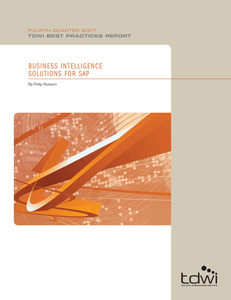
October 1, 2007
Providing business intelligence (BI) solutions for a business that uses SAP software continues to confound many users because of the long list of available options and the inherent complexity of such an undertaking. Yet, organizations need to clear these hurdles so they can benefit from a BI solution that provides visibility into business processes supported by applications from SAP and other vendors. This isn’t a new issue, but SAP customers need to revisit their BI solutions for SAP now, because many are old and need updating. In addition, new products and releases—from SAP and other vendors—have introduced more BI tool options.
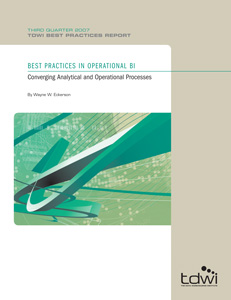
July 1, 2007
Operational business intelligence (BI) represents a turning point in the evolution of BI. Traditionally, BI has been the province of technically savvy business analysts who spend many hours with sophisticated tools analyzing trends and patterns in large volumes of historical data to improve the effectiveness of strategic and tactical decisions. But operational BI changes this equation: it moves BI out of the back room and embeds it into the fabric of the business, intertwining it with operational processes and applications that drive thousands of daily decisions. This report describes the promise of operational BI and provides suggestions about how to surmount the challenges involved in converging operational and analytical processes.
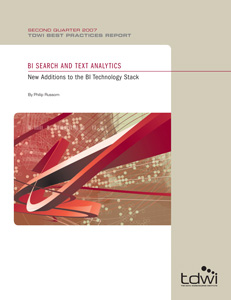
April 1, 2007
This report details how the expansion of the technology stack for business intelligence (BI) and data warehousing (DW) accommodates two relatively new additions, namely BI search and text analytics. Although each stands ably on its own, the two are related in that they tend to operate on unstructured data. Unstructured data is playing a larger role in BI and DW over time, and that role is today supported largely by tools and techniques for BI search and text analytics.
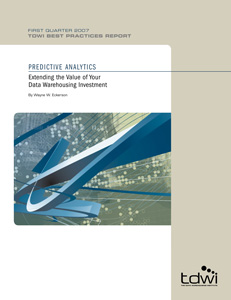
January 1, 2007
This report is designed for the business or technical manager who oversees a business intelligence (BI) environment and wishes to learn the best practices and pitfalls of implementing a predictive analytics capability. The report defines predictive analytics as a form of BI that uncovers relationships and patterns, within large volumes of data, that can be used to predict future behavior and events. Unlike other BI technologies, predictive analytics is forward-looking, using past events to anticipate the future.
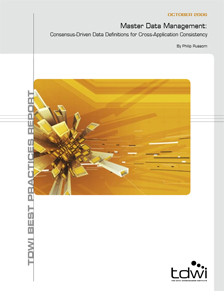
October 23, 2006
Although MDM has long been done in a few isolated silo applications, companies now practice it in more silos and with more connections among silos. Forward-looking companies even practice enterprise MDM, with a broad scope across many applications and businesses. As with many data management practices, the general trend in MDM is toward broader and better integrated enterprise scope.